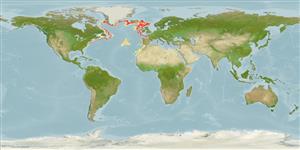| Native range | All suitable habitat | Year 2100 |

|
| Alepocephalus bairdii AquaMaps Data sources: GBIF OBIS |
Length at first maturity
Lm 55.0 range ? - ? cm
Human uses
Fisheries: minor commercial
Phylogenetic diversity index
(Ref. 82805)
PD50 = 0.5000 many relatives (e.g. carps) 0.5 - 2.0 few relatives (e.g. lungfishes)
Trophic Level
(Ref. 69278)
3.7 ±0.54 se; Based on food items.
Resilience
(Ref. 69278)
Low, minimum population doubling time 4.5 - 14 years (K=0.077; tmax=38; Fec = 458 (per batch))